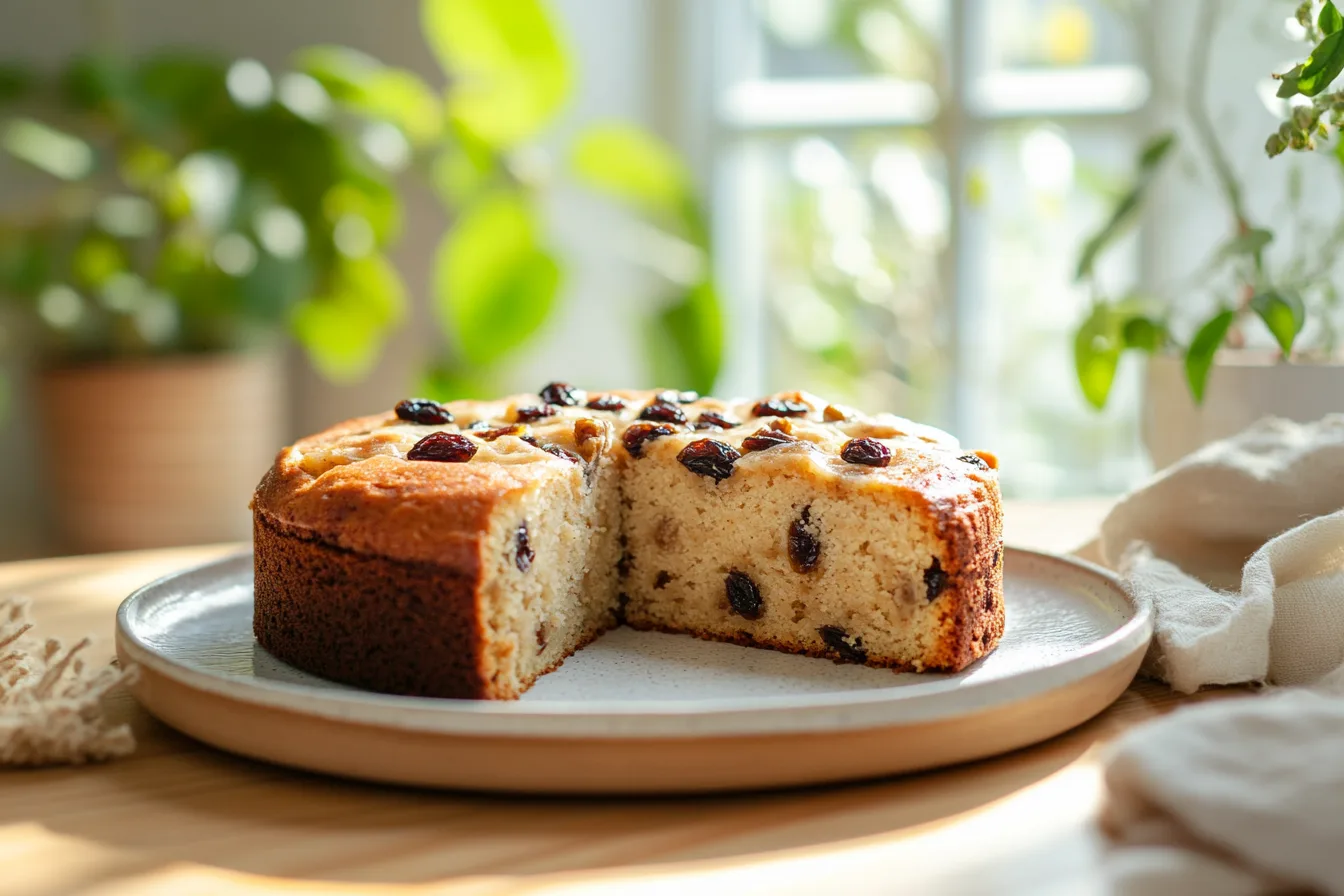Applesauce Cake Recipe You’ll Bake Again and Again…Cozy, Easy & Delicious !
Moist and Easy Applesauce Cake Recipe (A Delicious Old-Fashioned Dessert)
Table of Contents
Introduction
There’s something comfortingly nostalgic about an old-fashioned applesauce cake. The warm aroma of cinnamon and cloves filling the kitchen, the moist crumb studded with sweet raisins and crunchy walnuts – it’s pure cozy bliss. This article will guide you through a delicious applesauce cake recipe that’s simple to make yet yields an impressively flavorful cake. We’ll cover everything from what exactly an applesauce cake is, to tips for perfecting it, yummy variations, and more. Whether you’re an experienced baker or a newbie, you’ll find this guide friendly, informative, and just a bit fancy (in the most natural way). So, grab your apron and let’s dive into the world of applesauce cake!
What Is Applesauce Cake?
A moist applesauce cake slice topped with cinnamon-sugar. Applesauce cake is known for its tender crumb and warm spice flavor.
Applesauce cake is a type of dessert cake made with applesauce as one of the primary ingredients. In essence, it’s a moist spice cake that uses applesauce to add sweetness and lots of moisture to the batter. You’ll typically find cozy spices like cinnamon, cloves, nutmeg, or allspice in an applesauce cake, giving it that irresistible aroma reminiscent of autumn comforts. This cake often includes mix-ins such as raisins or nuts (common in traditional recipes) for extra texture and flavor.
Applesauce cakes have been enjoyed in American kitchens for well over a century. In fact, the recipe dates back to colonial times in the United States. It became especially popular during the early 1900s and wartime eras, when resourceful home bakers used applesauce as a substitute for scarce ingredients like eggs or butter. (Fun fact: there’s even a National Applesauce Cake Day celebrated on June 6th each year in the U.S!) Over time, this cake has remained a beloved classic – often served plain as a coffee cake, sometimes with a simple glaze or frosting, and always with a dose of nostalgia.
In short, applesauce cake is a humble yet delicious dessert that showcases the natural sweetness of apples and the warmth of spices. It’s the kind of cake you can enjoy as an afternoon snack with a cup of tea, as a sweet breakfast treat, or as a comforting dessert any day of the week.
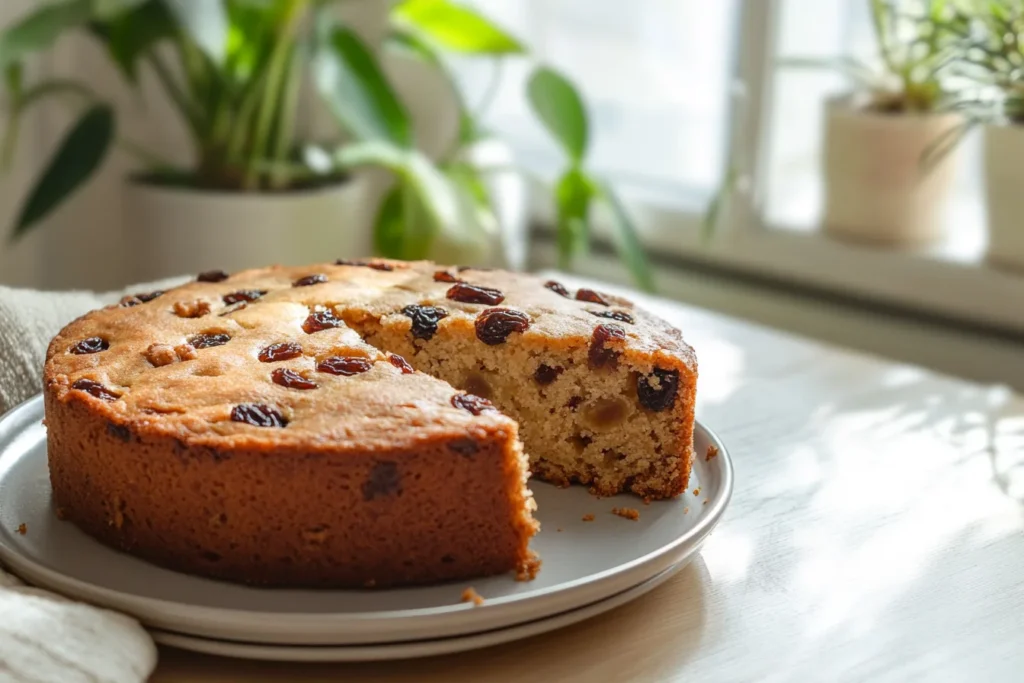
Ingredients Overview
Before we get into the step-by-step recipe, let’s go over the key ingredients you’ll need and why each is important. This overview will help you understand what makes this applesauce cake recipe so special. (We’ve included both US and metric units for convenience.)
- White Sugar – 1 cup (200 g): Regular granulated white sugar provides sweetness and structure to the cake. It also helps the cake achieve a tender texture by locking in moisture. (Feel free to use light brown sugar for part of this if you want a hint of molasses flavor, but the classic recipe uses white sugar for a clean sweetness.)
- Butter – ½ cup (113 g): Butter adds richness and a moist, tender crumb to the cake. In this recipe we cream the butter with sugar, which means beating them together to incorporate air. This process helps the cake be light and not too dense. Tip: Use softened unsalted butter for best results. (If you only have salted butter, you can use it and simply omit any added salt in the recipe.)
- Applesauce (chilled) – 1 cup (240 ml): Applesauce is the star of the show here. It brings natural sweetness, moisture, and a touch of apple flavor to the cake. Using unsweetened applesauce is recommended so you can control the sugar level and let the spices shine. The applesauce also acts as a binder (this recipe has no eggs, and the applesauce helps hold things together). We use chilled applesauce as per the recipe – this can help keep the batter cool when it’s mixed in, ensuring the butter doesn’t melt and the cake’s texture stays just right. You can use store-bought applesauce or homemade; just make sure it’s a smooth applesauce (chunky applesauce can be used, but note that cakes made with chunky applesauce may turn out a little less moist than those with a smooth puree).
- All-Purpose Flour (Plain Flour) – 2 cups (about 240 g): Flour provides the structure for our cake. All-purpose (or “plain” flour in the UK) has the right amount of protein (gluten) to give a good structure without making the cake too heavy. Be sure to measure your flour correctly (spooning it into the cup and leveling off, or using a scale for ~240 g) so the cake doesn’t end up dry from too much flour.
- Baking Soda – 1 teaspoon (5 ml): This is our leavening agent. Baking soda reacts with the acidity in the applesauce to produce carbon dioxide bubbles, which help the cake rise and become fluffy. Because this recipe uses baking soda (and no baking powder), it’s important that your applesauce has some natural acidity and that you bake the batter promptly after mixing (so the bubbles don’t fizzle out). Make sure your baking soda is fresh for best results – old baking soda can lose its potency, leading to a flatter cake.
- Ground Cinnamon – 1 teaspoon (about 2-3 g): Cinnamon is the primary spice, giving the cake its signature warm, sweet-spicy flavor. The combination of apple and cinnamon is a classic for good reason – it’s delicious and aromatic. This amount will give a nicely spiced cake without overpowering the apple.
- Ground Cloves – ¼ teaspoon (a pinch, ~0.5 g): Cloves are a strong spice, so a little goes a long way. That quarter-teaspoon of ground cloves adds depth and a cozy, old-fashioned aroma to the cake that really makes it special. Together with cinnamon, it creates that “spice cake” flavor. (If you’re not a fan of cloves, you can reduce it or substitute with a bit of nutmeg or ginger – see Variations section – but the classic recipe’s balance is wonderful as is.)
- Chopped Walnuts – ½ cup (about 55–60 g): Walnuts add a delightful nutty flavor and crunchy texture in each bite. They pair beautifully with apples and spices. Be sure to use chopped walnuts (you can buy them chopped, or chop whole walnuts yourself) so they distribute evenly. If you’re not a walnut fan or have allergies, you can omit them or substitute with pecans, almonds, or other nuts (or see Variations for a nut-free idea).
- Raisins – ½ cup (about 75 g): Juicy raisins bring bursts of sweetness and chewiness throughout the cake. They’re a traditional addition to applesauce cake and complement the apple and spice flavors. If raisins aren’t your thing, you can leave them out or swap them with dried cranberries, chopped dates, or even golden raisins for a twist. Just like with the nuts, ensure they are evenly distributed in the batter (we’ll talk about a trick to prevent them from sinking in the Tips section).
These simple ingredients come together to create a wonderfully moist, flavorful applesauce cake. Many of them are pantry staples, so you might already have everything on hand. Now, let’s get into how to actually make the cake step by step!
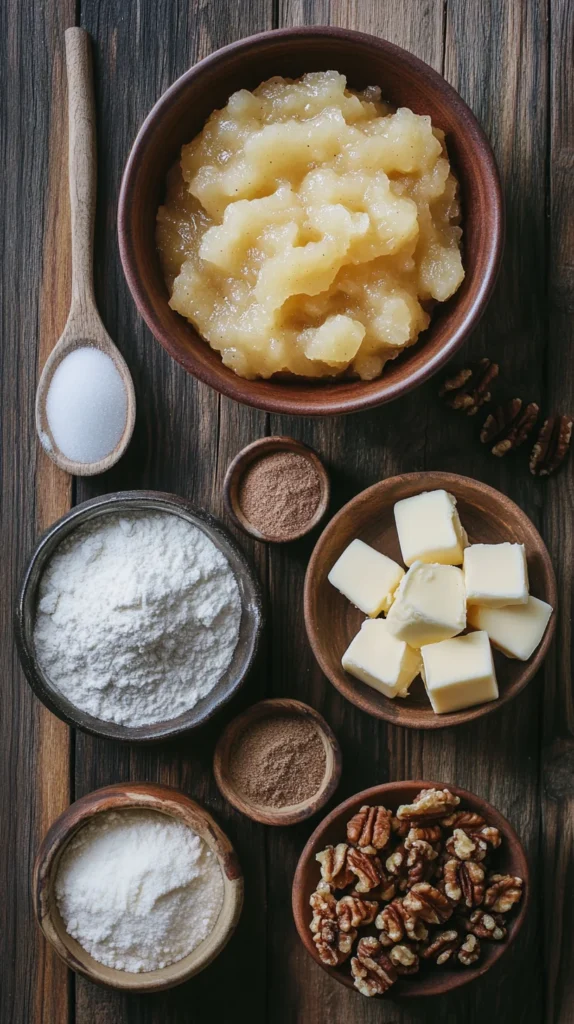
Step-by-Step Preparation Guide
Ready to bake? Follow this easy guide to make your applesauce cake. This recipe doesn’t require any advanced techniques – just basic baking steps that even a beginner can manage. By the end, your kitchen will smell heavenly and you’ll have a delicious cake to enjoy.
Before you start:
Preheat your oven to 350°F (175°C) and gather your ingredients. Also, grease and flour an 8-inch cake pan (which is about 20 cm in diameter) so it’s ready for the batter. Greasing and flouring the pan will help the cake release easily after baking.
Now, let’s go through the steps:
- Preheat and Prepare the Pan: Preheat your oven to 350°F (175°C). While it’s heating, grease and flour an 8-inch round cake pan. To do this, use a little butter or cooking spray to coat the inside of the pan, then sprinkle in a tablespoon of flour and tap it around so it sticks to the greased surface (dump out the excess flour). This will prevent the cake from sticking to the pan.
- Cream the Sugar and Butter: In a large mixing bowl, combine the 1 cup of white sugar and ½ cup of softened butter. Beat them together until the mixture is creamy and pale. You can use an electric hand mixer or stand mixer for this, or even do it by hand with a sturdy spoon (though it will take some elbow grease!). Creaming the butter and sugar creates tiny air pockets that will help leaven the cake, so mix for about 2-3 minutes until it’s light and fluffy.
- Add the Applesauce: Pour in the 1 cup of chilled applesauce to the butter-sugar mixture. Beat or stir well until the applesauce is fully incorporated. It might look a bit curdled or separated at first (especially if the applesauce is cold against the room-temperature butter), but keep mixing and it will come together. This blend of applesauce, butter, and sugar is the wet base for your cake.
- Mix in the Dry Ingredients: In a separate bowl, whisk together the dry ingredients – 2 cups of all-purpose flour, 1 teaspoon baking soda, 1 teaspoon ground cinnamon, and ¼ teaspoon ground cloves. Make sure they’re well combined, so the spices and leavening are evenly distributed. Now, gradually add the dry mixture into the wet mixture (the applesauce/butter bowl). You can do this in two or three additions, stirring gently after each addition. Stir just until the flour is moistened and no obvious streaks of dry ingredients remain. It’s important not to overmix at this stage – overmixing can develop the gluten in the flour too much and make the cake tough. A few small lumps in the batter are okay; you just don’t want big pockets of dry flour.
- Fold in the Walnuts and Raisins: Add the ½ cup of chopped walnuts and ½ cup of raisins to the batter. Using a spatula or wooden spoon, gently fold them in. Folding means to incorporate by scraping down the sides and bottom of the bowl and turning the batter over on itself, rather than vigorous stirring. This helps distribute the nuts and raisins without overmixing the batter. Try to get them evenly dispersed so every slice of cake will have some raisins and nuts. (If you want to be extra sure your mix-ins don’t sink, you can toss the walnuts and raisins with a teaspoon of flour before adding them – this light coating of flour can help keep them suspended in the batter.)
- Transfer to Pan and Bake: Spoon the batter into your prepared 8-inch pan. Use the back of a spoon or spatula to spread the batter out evenly in the pan. It will be somewhat thick. Place the pan in the preheated oven (350°F/175°C) on the middle rack. Bake for about 40 minutes, or until a toothpick or cake tester inserted into the center of the cake comes out clean. Every oven is a little different, so you might start checking a couple minutes early, or it could take a few minutes longer. The top of the cake should look golden brown and may have a few cracks – that’s normal. You’ll also notice the wonderful smell filling your kitchen as it nears doneness.
- Cool and Serve: Once the cake is baked through, remove it from the oven. Allow it to cool in the pan on a wire rack for about 10 minutes – this brief cooling helps the cake firm up a bit so it doesn’t break apart. Then, if you wish, you can turn the cake out onto the rack to cool longer, or you can just leave it in the pan. Applesauce cake is often enjoyed warm, so feel free to slice a piece after it’s had those 10 minutes to rest. Serve it as is, or with a little butter on top, or a dollop of whipped cream. Enjoy the cake warm for the best flavor and texture. (If you plan to frost or glaze it, let it cool completely before doing so.)
That’s it! You’ve made a lovely applesauce cake from scratch. This cake is fantastic warm, but it’s also good at room temperature – and some say it gets even better the next day as the flavors mingle. Now that you have the basic recipe down, let’s talk about some ways you can change it up or dress it up.

Variations to Try
One of the great things about a simple recipe like this is how easy it is to adapt to your taste or dietary needs. Here are some fun variations and tweaks you can try with this applesauce cake recipe:
- Add a Simple Glaze or Frosting: Although applesauce cake is often served plain, you can certainly dress it up. Try drizzling a basic vanilla glaze over the cooled cake (mix 1 cup of powdered sugar with a tablespoon or two of milk or apple juice until smooth). The sweet glaze with a hint of apple flavor is delicious. For something more decadent, a cream cheese frosting with a pinch of cinnamon is a fabulous topping. A caramel glaze is another classic choice that pairs beautifully with the apple and spice notes – simply boil brown sugar, butter, and a bit of cream to make a quick caramel drizzle. Even a light dusting of powdered sugar on top can give the cake a pretty, sweet finish.
- Whole Wheat or Multigrain Twist: If you want to incorporate whole grains, you can substitute half of the all-purpose flour with whole wheat flour. This will give the cake a slightly nuttier flavor and heartier texture (and a bit more fiber). The cake may be a tad more dense, but it will still be moist and tasty. For a more adventurous spin, some bakers even use a mix of whole wheat and oat flour or throw in a handful of oats. If you go with entirely whole wheat flour, you might need to add an extra tablespoon of applesauce or a splash of milk to ensure it isn’t too heavy.
- Make It Vegan: Good news – this recipe is already egg-free, and the only dairy ingredient is the butter. To make a fully vegan applesauce cake, substitute the ½ cup butter with ½ cup of vegetable oil or a plant-based butter. Using oil will make the cake very moist (and it simplifies the process since you don’t need to cream oil, you can just mix it with the sugar). Choose a neutral oil like canola or a mild olive oil. Also be sure to use sugar that is vegan (in some regions, white sugar is filtered with bone char, so opt for organic sugar if that’s a concern). With those tweaks, the rest of the ingredients are already vegan-friendly. The resulting cake will be dairy-free and egg-free, yet still soft and delicious.
- Gluten-Free Option: You can adapt this recipe for gluten-sensitive diets by using a gluten-free all-purpose flour blend (look for one that says it’s a 1:1 replacement for regular flour). Another approach is to use rice flour or a mix of rice flour and almond flour, which some recipes use for applesauce cake. Keep in mind, gluten-free flours might change the texture slightly (the cake may be a bit more crumbly), but the applesauce keeps it moist so it should still come out nicely. Also check that your baking soda and other ingredients are certified gluten-free if needed (most are naturally gluten-free, but oats or flour blends might not be).
- Different Mix-Ins: While walnuts and raisins are the traditional combo, you can absolutely experiment with others. Some ideas: swap the walnuts for pecans (pecans + apples and cinnamon are wonderful together), or use sliced or slivered almonds. Instead of raisins, try dried cranberries for a tart burst of flavor, or chopped dates for extra sweetness. Even chocolate chips can be mixed in for a less traditional but kid-friendly twist – imagine little pockets of melty chocolate in the spiced apple cake (if using chocolate, you might want to omit cloves and stick just with cinnamon). You can also increase the total amount of mix-ins slightly if you love a very chunky cake, just be careful not to add so much that the batter is overwhelmed.
- Extra Spice or Different Spices: The recipe calls for cinnamon and cloves, but you can play with the spice profile. Many applesauce cake recipes also include a bit of nutmeg or allspice. You could add ¼ teaspoon of nutmeg for a warmer, earthier flavor, or swap the cloves for allspice to mellow the bite. Freshly grated ginger or even crystallized ginger pieces can add a zesty punch (a couple teaspoons of fresh grated ginger would blend well). Feel free to adjust spices to your liking – if you adore cinnamon, you might add an extra ½ teaspoon. Just remember that spices like cloves and nutmeg are potent, so a little goes a long way.
- Applesauce Cupcakes or Loaf: This batter is quite versatile. You can make applesauce cupcakes by dividing the batter into a muffin tin lined with papers (you’ll get roughly 12 cupcakes). Bake them at 350°F (175°C) for a shorter time, about 18-22 minutes, until they test done. These make great lunchbox treats! Alternatively, bake the batter in a loaf pan to create a quick-bread style applesauce loaf – you’ll need to adjust the bake time (likely around 50-55 minutes for a 9×5-inch loaf pan). A Bundt pan is another option for a pretty presentation; just make sure to grease it very well, and expect the cake to bake a bit faster if your bundt pan makes the batter shallower, or a bit longer if it’s deeper (start checking around 35 minutes for a small bundt).
As you can see, there are plenty of ways to make this applesauce cake your own. Feel free to get creative! No matter the variation, you’re still going to end up with a delightful cake that carries that comforting apple-cinnamon essence.
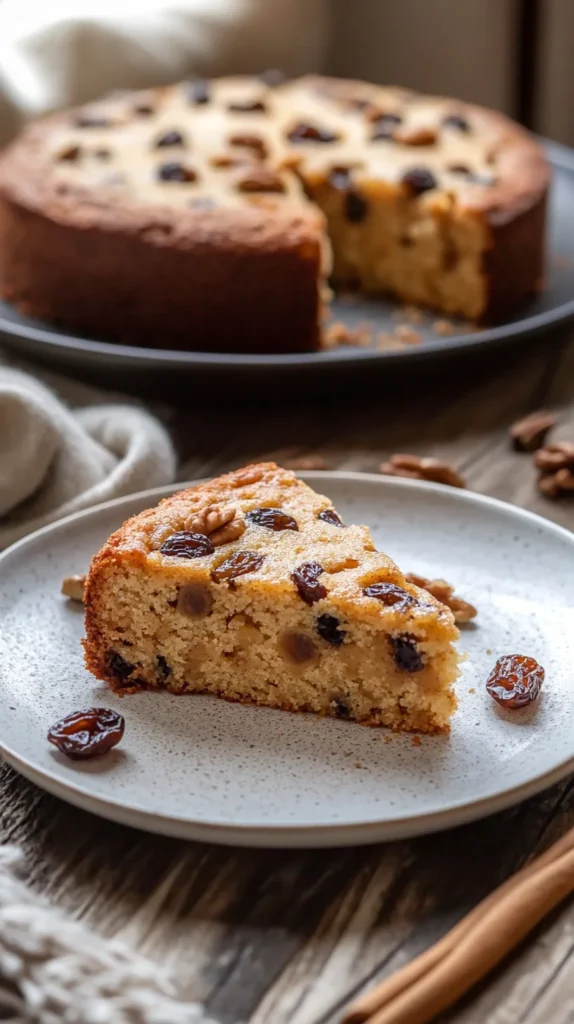
Serving Suggestions
You’ve baked your applesauce cake – now how should you enjoy it? Here are some serving suggestions to make each slice even more delightful:
- Serve it Warm: Applesauce cake is wonderful warm. If it’s cooled completely, you can gently reheat slices in the microwave for 10-15 seconds or warm them in a 300°F (150°C) oven for a few minutes. A warm slice really brings out the aroma and softness of the cake.
- Top with Whipped Cream or Ice Cream: For a dessert vibe, add a dollop of whipped cream on top of each slice. The light cream goes great with the spiced cake. In warmer months, a scoop of vanilla ice cream alongside a warm slice of applesauce cake is heavenly – like apple pie and ice cream, but in cake form! The cold, creamy ice cream melting onto the spiced cake is a real treat.
- Dust with Powdered Sugar: If you want a simple, elegant presentation, place a doily or stencil on top of the cake and sift powdered sugar over it, then lift the stencil. Or just give a light snowfall of powdered sugar across the top. It adds a touch of sweetness and looks pretty, which is perfect if you’re serving the cake for guests or a special occasion.
- Drizzle of Caramel or Sauce: As mentioned in variations, a caramel sauce can be drizzled over slices for extra indulgence. You could also serve each slice with a spoonful of warm applesauce on the side or over top (great if you really love apple flavor). Another idea is a light vanilla custard or sauce Anglaise drizzled over the cake, which gives a lovely creamy element.
- Breakfast or Brunch: Don’t hesitate to enjoy this cake in the morning. It pairs amazingly with a cup of coffee or tea. Because it’s not iced, it can absolutely pass as a sweet breakfast bread. Try serving a slice with some Greek yogurt and fresh fruit on the side for a filling breakfast. It also makes a nice addition to a brunch spread – something a little different from the usual coffee cake or banana bread.
- Add Fruit on the Side: A slice of applesauce cake goes well with fresh fruit. In the fall, serve it with slices of fresh apple or a warm cinnamon apple compote. In spring, some fresh berries on the plate can add a pop of color and tartness to complement the sweet cake. A spoonful of applesauce (perhaps chunky style) on top of each slice can reinforce the apple theme and add moisture.
- Storing for Later: If you’re not serving the cake all at once, keep it covered (under a cake dome or wrapped in plastic wrap/aluminum foil). This cake stays moist for several days when stored at room temperature. In fact, many say the flavor is even better the next day, so it’s a great make-ahead dessert. For longer storage, you can refrigerate it (tightly wrapped) for up to about 5 days, but let slices come to room temp or warm them slightly to serve, as chilled cake can firm up.
The beauty of applesauce cake is that it’s just as good unadorned as it is dressed up. Whether you grab a quick slice on the go or plate it elegantly for friends, it’s bound to satisfy. Enjoy it in whatever way makes you happiest!
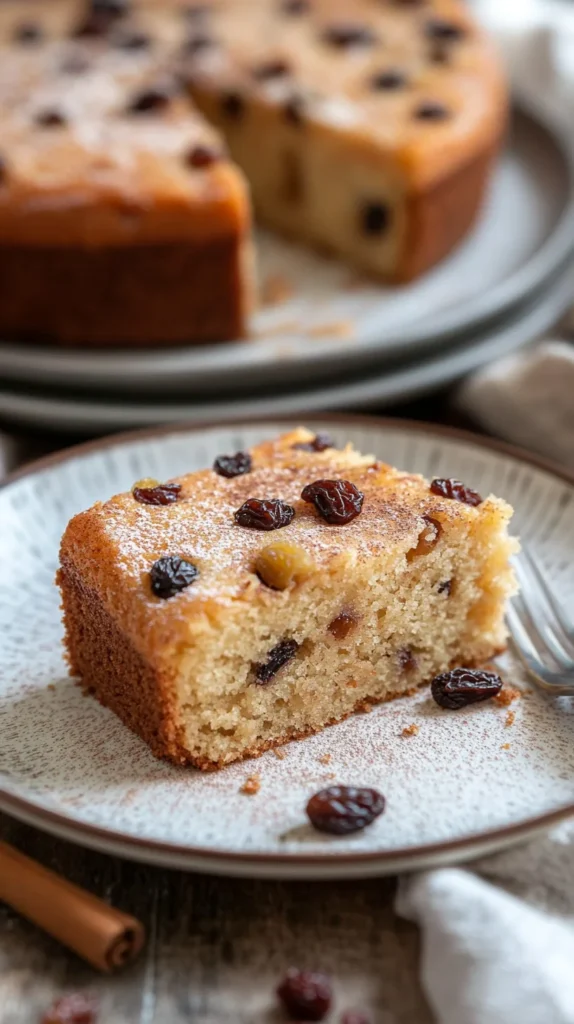
Tips and Tricks for the Perfect Applesauce Cake
Baking is as much an art as a science, and a few simple tips can make your applesauce cake turn out absolutely perfect. Here are some handy tips and tricks to keep in mind:
- Use Unsweetened Applesauce: We mentioned this before, but it’s worth emphasizing. Use unsweetened applesauce so your cake isn’t overly sugary. This gives you full control over the sweetness. If you only have sweetened applesauce, consider reducing the sugar in the recipe by a couple of tablespoons to compensate.
- Measure Ingredients Accurately: For baking, accurate measurements are key. Use measuring cups/spoons or a kitchen scale for precision. Too much flour (from scooping the cup directly into the flour jar, for example) can make the cake dry. To measure flour correctly, fluff it up, spoon it into the measuring cup, and level it off with a knife – or better yet, weigh 240 grams. The same goes for the other ingredients: use the right cups for liquids vs solids if applicable, and level off your teaspoons for spices and soda.
- Butter Should Be Soft (but Not Melted): When creaming butter and sugar, the butter should be at room temperature (soft enough that a finger can press into it easily, but not shiny or melted). Soft butter creams properly with sugar to trap air. If it’s too cold, it won’t mix well; if it’s melted, you lose the air pockets and get a heavier cake. Plan ahead and take your butter out of the fridge 30-60 minutes before baking.
- Don’t Worry if Batter Looks Curdled: When you add cold applesauce to the creamed butter, the mixture might look a bit split or curdled – this is normal. The cold temperature can cause the butter to form tiny lumps. As soon as you start adding flour, it will all smooth out. So don’t panic; just continue with the recipe.
- Do Not Overmix the Batter: Once the flour is added, mix gently and just until combined. Overmixing develops gluten which can make your cake tough or rubbery. A tender applesauce cake needs a light hand. It’s okay if the batter isn’t completely silky – a few small lumps are fine and will hydrate during baking.
- Prevent Raisins and Nuts from Sinking: Ever had all your raisins sink to the bottom of a cake? To avoid that, toss the raisins and nuts with a teaspoon of flour before folding them into the batter. This light coating of flour helps them “stick” in the batter rather than dropping to the bottom during baking. Also, fold them in at the end, and don’t overmix (which could also contribute to sinking).
- Use the Right Pan Size: The recipe calls for an 8-inch pan. Using a significantly different size will affect the cake’s baking. For instance, a 9-inch pan will make a thinner cake that bakes faster (as one Allrecipes reviewer noted, their 9-inch cake was done in 30 minutes). If you only have a 9-inch round, start checking earlier. If you use a loaf pan or other shape, times will vary. Generally, keep an eye on color and do the toothpick test for doneness.
- Check for Doneness Properly: The toothpick test is a great indicator – poke a toothpick or thin skewer into the center. If it comes out clean or with just a couple of cooked crumbs, the cake is done. If it comes out with wet batter, give the cake more time. Also, you can lightly press the top of the cake; it should spring back when done. The edges may start to pull away from the pan a bit as another sign.
- Cooling Matters: Let the cake cool a bit before slicing, as a very hot cake may crumble. However, do serve it warm if you can – that’s when the taste and texture shine. If you plan to frost the cake, always cool it completely first, or your frosting will melt.
- Enhance the Flavor (Optional): While not in the original recipe, you can add a teaspoon of pure vanilla extract to the batter after adding the applesauce. Vanilla complements the apple and spice flavors nicely and can elevate the aroma. Another optional boost: a tiny pinch of salt (about 1/4 teaspoon) in the batter can enhance all the flavors (especially if you used unsalted butter, a bit of salt is a good idea). These little additions aren’t necessary, but can be nice tweaks if you wish.
- Storage Tip: Applesauce cake tends to stay moist because of the applesauce content, so it keeps well. Store it tightly wrapped or in an airtight container. It will stay fresh on the counter for 2-3 days. If you need to keep it longer, refrigerate it (up to about 5 days) and bring slices to room temp before eating (or give a quick zap in the microwave). You can also freeze applesauce cake successfully – see the FAQ for details on that.
By following these tips, you’ll set yourself up for success. Baking is all about those little details, and now you’re equipped with the know-how to make an applesauce cake that would make Grandma proud. Happy baking!
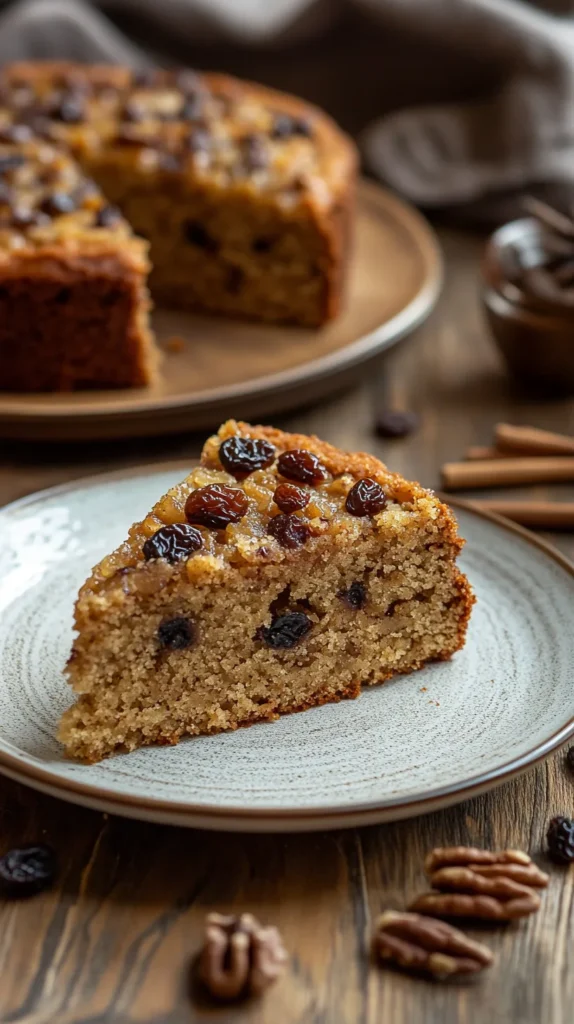
Nutritional Information
If you’re curious about what’s in each slice of this yummy cake, here’s an approximate nutritional breakdown. This is for one serving (one slice of cake, assuming you cut an 8-inch cake into 8 equal pieces). Keep in mind this is without any additional glaze or frosting. Adding toppings will change these values slightly.
| Nutrient | Per Serving (approx) |
| Calories | ~400 kcal |
| Carbohydrates | ~60 g |
| Protein | ~5 g |
| Fat | ~17 g |
| Saturated Fat | ~8 g |
| Cholesterol | ~30 mg |
| Sodium | ~170 mg |
| Dietary Fiber | ~2 g |
| Total Sugars | ~33 g |
Explanation: Most of the calories in this cake come from carbohydrates (sugar, flour, raisins) and fats (butter, walnuts). The applesauce contributes to the carbs but also provides some fiber. Each slice has about as much sugar as you’d expect from a sweet slice of cake – the equivalent of a few tablespoons of sugar. On the plus side, the use of applesauce in place of additional butter or eggs means the fat and cholesterol content is a bit lower than some other cakes. The walnuts add healthy fats (and a little protein and fiber). So while this cake is definitely a treat and not a health food, it does have some wholesome aspects (fruit and nuts) and is a bit lighter than a butter-heavy cake with frosting.
If you need to tweak the nutrition (say, lower the sugar or fat), consider some of the variations we discussed (like using part whole wheat flour for more fiber, or reducing sugar slightly if using sweetened applesauce, etc.). But overall, enjoyed in moderation, this applesauce cake can be part of a balanced approach to treats. And it certainly beats many store-bought cakes which often have preservatives or heavier icing.
Common Mistakes to Avoid
Even simple recipes can have their pitfalls. To ensure your applesauce cake turns out perfect, watch out for these common mistakes:
- Using Sweetened Applesauce Without Adjustments: If all you have is sweetened applesauce, the cake will still work, but many folks make the mistake of not adjusting the sugar. Sweetened applesauce adds extra sugar to the recipe, which can make the cake too sweet and possibly alter the texture. If you must use sweetened, consider cutting back the added white sugar by a few tablespoons so the cake isn’t cloying.
- Not Creaming Butter and Sugar Properly: Skipping or rushing the creaming step can lead to a dense cake. Make sure you beat that butter and sugar until it’s pale and fluffy. If you don’t cream enough, the sugar won’t be as dissolved and the batter won’t have as much air incorporated. This mistake can cause a heavier texture. So take the extra two minutes to cream well – it makes a difference.
- Adding Flour All at Once: Dumping in all the flour mixture in one go and then stirring vigorously can overdevelop gluten or create lumps. Always add dry ingredients gradually and gently mix. This avoids a lumpy batter and prevents overmixing. Remember, overmixing = tougher cake. Once the flour is in, use a light hand.
- Forgetting to Preheat the Oven or Using the Wrong Temperature: Putting your cake in a lukewarm oven can result in poor rise and uneven baking. Always preheat fully to 350°F (175°C) before the cake goes in. Similarly, double-check that it’s the correct temperature – 350°F is standard for this kind of cake. If you accidentally set it higher, the cake might brown too quickly and undercook inside; if set lower, it could come out heavy. An oven thermometer is helpful if your oven tends to be off.
- Overbaking the Cake: Keep an eye on the clock and check the cake at around 38-40 minutes (for an 8-inch pan). Overbaking will dry out the cake, even with the applesauce. If your toothpick is coming out clean and the cake looks done, take it out. Some people leave it “just to be sure” and end up with a drier result. Remember the cake will continue to cook for a minute or two from residual heat after removing from the oven.
- Ignoring Pan Size Differences: If you use a pan that’s not 8 inches, be mindful of how that changes things. A larger pan (9 inch) will make a thinner cake that bakes faster (you might need to reduce time by ~5-10 minutes). A smaller or taller pan will need more time. One mistake is to stick rigidly to the 40 minutes without considering your pan; this can lead to undercooking or overcooking. Adapt and test with a toothpick as needed.
- Not Greasing/Flouring the Pan Well: There’s nothing sadder than a delicious cake that’s stuck to the pan! Make sure you thoroughly grease the pan and then flour it. Missing a spot could cause part of the cake to cling. If you have parchment paper, you can also line the bottom of the pan with a round of parchment after greasing – then flour the sides. This virtually guarantees a smooth release. Neglecting this prep step is a common mistake that’s easy to avoid.
- Cutting While Too Hot: It’s hard to be patient when the kitchen smells so good, but try not to cut the cake immediately out of the oven. It’s very tender when extremely hot and might crumble or break. Let it cool for those 10 minutes in the pan to set the structure a bit. If you try to flip it out of the pan too quickly, it may also crack. So give it that brief rest.
- Storing Improperly: If you leave the cake uncovered on the counter, it can dry out (even this moist cake will lose moisture over time). Another mistake is to put it in the fridge unwrapped – refrigerators tend to dry cakes out unless they’re sealed. Always wrap leftover cake or keep it under a cover. If you live in a very humid area, you might want to refrigerate to avoid mold, but again, wrap it well. And for freezing, double wrap (plastic wrap + foil) to prevent freezer burn.
Avoid these pitfalls, and you’re likely to have a wonderfully successful baking experience. And if something does go a little wrong, don’t be discouraged – even less-than-perfect applesauce cake is still quite delicious (serve it with ice cream if it’s a bit dry, and no one will complain!).
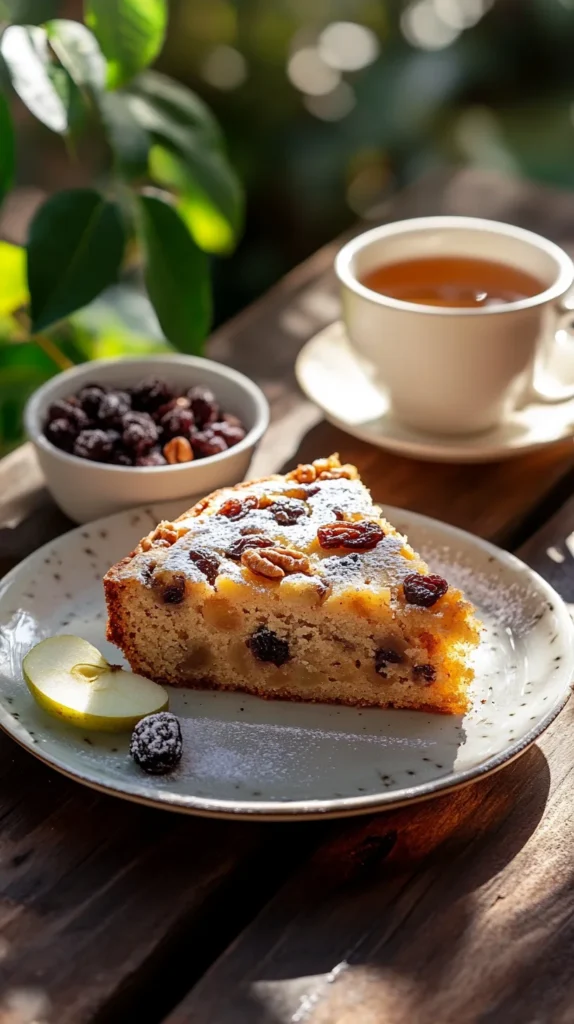
Frequently Asked Questions
To wrap up, let’s address some common questions bakers often have about making applesauce cake. Here are five frequently asked questions and their answers:
Can I use sweetened applesauce instead of unsweetened?
Yes, you can, but you should reduce the amount of added sugar in the recipe so the cake isn’t overly sweet. If using sweetened applesauce, try cutting the white sugar down by 2–4 tablespoons. This way, the balance of sweetness remains just right and your cake won’t end up cloying. The flavor may also be slightly different if the sweetened applesauce has added spices or flavors, but overall it will still work well.
How do I store applesauce cake and how long will it stay fresh?
Applesauce cake can be stored at room temperature, covered tightly with plastic wrap or in an airtight container. It will stay fresh and moist for about 2 to 3 days at room temp. For longer storage, you can refrigerate it (well-wrapped) for up to about 5 days. Just remember that refrigeration can sometimes dry out cakes a bit, so bring it to room temperature or warm it for a few seconds in the microwave before serving. Many bakers actually find that the cake tastes even better the next day, as the spices and apple flavor have time to meld.
Can I freeze applesauce cake?
Absolutely! Applesauce cake freezes very well. To freeze, let the cake cool completely. Then wrap it tightly in plastic wrap, and again in aluminum foil (or place the wrapped cake in a zip-top freezer bag). This double-wrapping prevents freezer burn and keeps odors out. You can freeze the whole cake or individual slices. It will keep in the freezer for about 2 to 3 months. When you’re ready to enjoy it, thaw the cake overnight in the refrigerator (still wrapped to avoid condensation). Once thawed, bring it to room temperature or warm up slices gently. If you plan to add any powdered sugar on top, do that after thawing, just before serving (moisture during thawing could dissolve it).
I don’t like raisins/nuts. Can I leave them out or substitute them?
Definitely. The raisins and walnuts are completely optional add-ins. If you’re not a fan, you can simply omit one or both, and you’ll have a lovely spiced applesauce cake with no chunks. You can also substitute them. For raisins, alternatives include dried cranberries, chopped dried apricots, or dates. For nuts, you can use pecans, almonds, or hazelnuts. If leaving nuts out entirely, you might consider adding an extra ¼ cup of raisins or a different dried fruit to maintain some texture (or not – it’s up to you!). The recipe is quite flexible, and the core cake will bake just fine without these mix-ins.
Can I use oil instead of butter in this recipe?
Yes, you can replace the ½ cup of butter with ½ cup of vegetable oil (such as canola or sunflower oil). In fact, many applesauce cake recipes use oil, which makes the cake incredibly moist. If using oil, you won’t need to cream it with the sugar like you do with butter. Instead, mix the sugar, applesauce, and oil together, then add the dry ingredients. The texture of the cake might be a bit more plush and the flavor slightly different (you’ll miss a bit of the buttery taste), but it will still be delicious. This substitution is great if you want a dairy-free cake or just to save time. Just be sure not to use an oil with a strong flavor (like olive oil can sometimes be too strong, unless it’s very light).
Hopefully, these FAQs clear up any remaining doubts. If you have other questions, feel free to experiment – cooking is all about learning and making a recipe fit your own style!
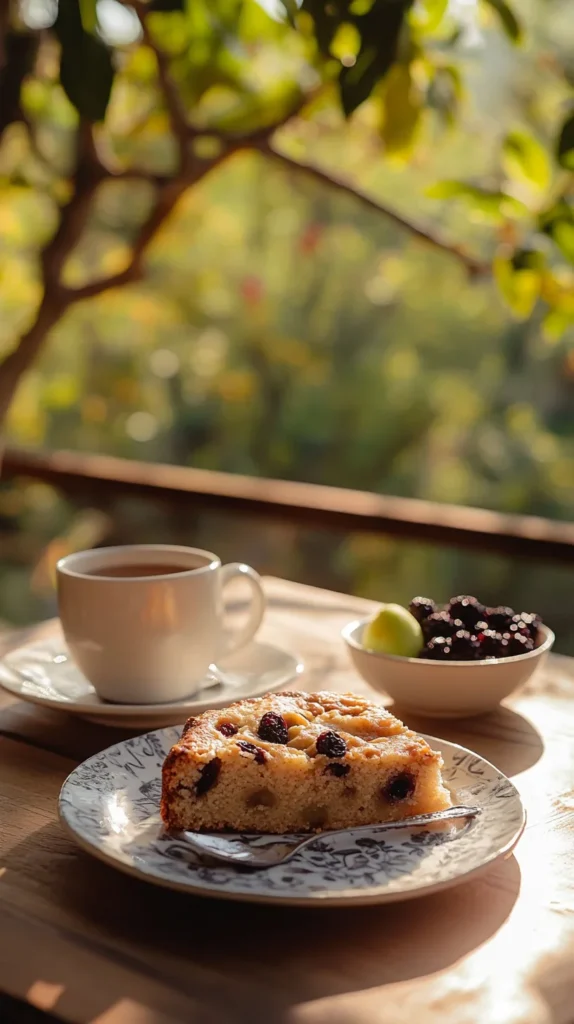
Final Thoughts on the Perfect Applesauce Cake
Baking the perfect applesauce cake is truly a joy, and we hope this comprehensive guide has inspired you to give it a try. With its moist texture, fragrant spices, and the homey sweetness of applesauce, this cake embodies comfort in every bite. It’s a recipe that has stood the test of time – from colonial American kitchens to modern ovens – and for good reason. It’s easy to make, uses simple ingredients, and produces wonderful results.
As you’ve seen, there are many ways to enjoy and customize an applesauce cake. You might keep it classic for a taste of nostalgia, or put your own twist with fun variations. No matter what, the heart of the cake remains the same: it’s all about that applesauce bringing everything together into a tender, flavorful treat.
So the next time you crave something a little sweet and a lot comforting, remember this applesauce cake recipe. It’s perfect for a family gathering, a cozy tea-time snack, or just because you have some applesauce to use up and want to bake! We’re confident that with the tips and instructions provided, you’ll bake an applesauce cake that will wow your taste buds and perhaps even start a new tradition in your home.
Happy baking, and enjoy every slice of your delightful applesauce cake! (Now, time to put on the kettle and savor a well-earned piece of cake…)
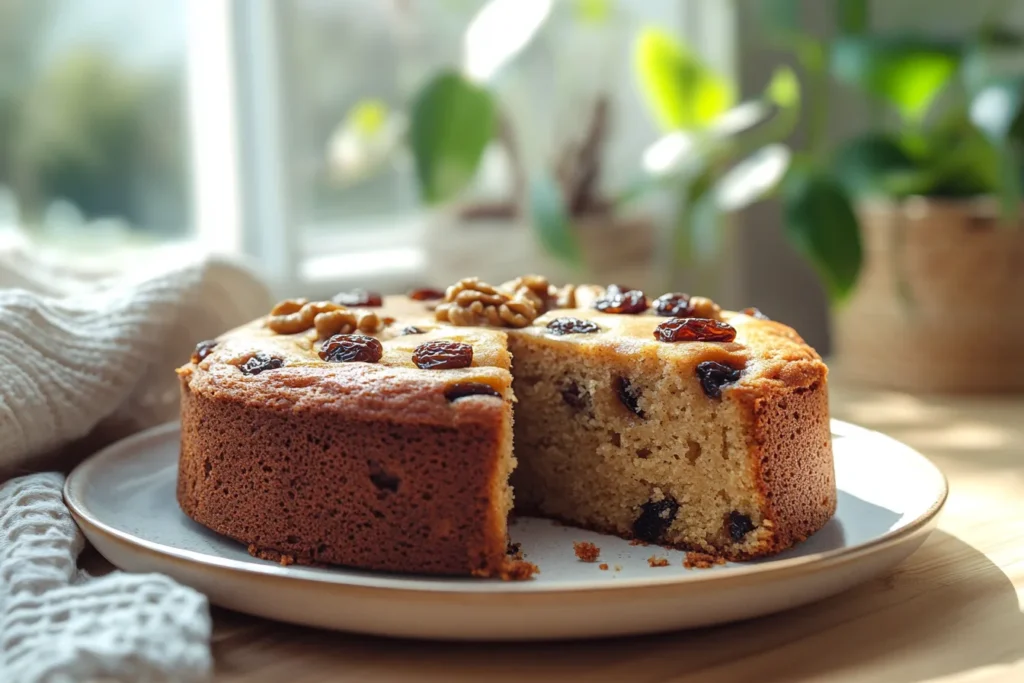
Applesauce cake is one of those timeless bakes that never goes out of style – but if you’re in the mood to try something different next time, check out my banana bread with just 2 bananas or treat yourself to my homemade version of Crumbl cookies. You’ll love them just as much!

